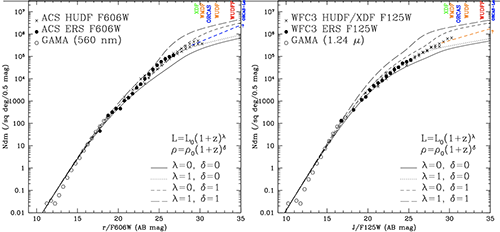High Redshift Universe
In the last three decades, major progress has been made in studies of galaxy assembly with the Hubble Space Telescope (HST) and through targeted programs using Adaptive Optics (AO) on the world's best ground-based facilities. It is not possible to review all these efforts here; we refer the reader to more detailed reviews. In, we reviewed the advantages of high resolution science on high redshift galaxies from the ground as compared to from space. In short, diffraction limited space-based imaging provides much darker sky over a wider FOV, more stable PSF's, better dynamic range, and therefore superior sensitivity, including in the vacuum-UV. But ground-based multi-conjugate AO (MCAO) on 8 - 10 meter telescopes is complementary to space-based imaging, as it can provide much higher spatial resolution – and spectral resolution – than what space-based telescopes can currently do.

[Right]: As Fig. a, but in the J-band or HST WFC3/IR F125W filter. The colored labels indicate the various HUDF/XDF, Webb and ORCAS detection limits without and with lensing. To AB≤31 mag in both filters, ORCAS will yield about 5×106 faint star-forming (SF) clumps per square degree, or ~0.4 per arcsec2, or one in every box of 1.6×1.6".
Science Objectives:
Constrain the number densities of faintest Star Forming clumps and constrain their physical size. Follow up with ORCAS on caustic transits of individual stars in star forming clumps detected by HST and JWST.
Observable and Measurements:
A minimum of 10 ORCAS fields to formulate a census for ~ 100 of these faint star forming clumps.
Key Functional Requirements:
A 5" × 5" FOV with a minimum wavelength coverage of 0.5 - 1.2 µm. Deep images to AB ≤ 29 mag (10 σ) for point sources in a few hours, or 31 mag using notch filters for the spectral regions with the brightest night sky-line. Spatial resolution of ~ 0.01" - 0.02" FWHM with good Strehl ratios.
ORCAS Uniqueness:
ORCAS can provide strong sensitivity at shorter wavelengths.
